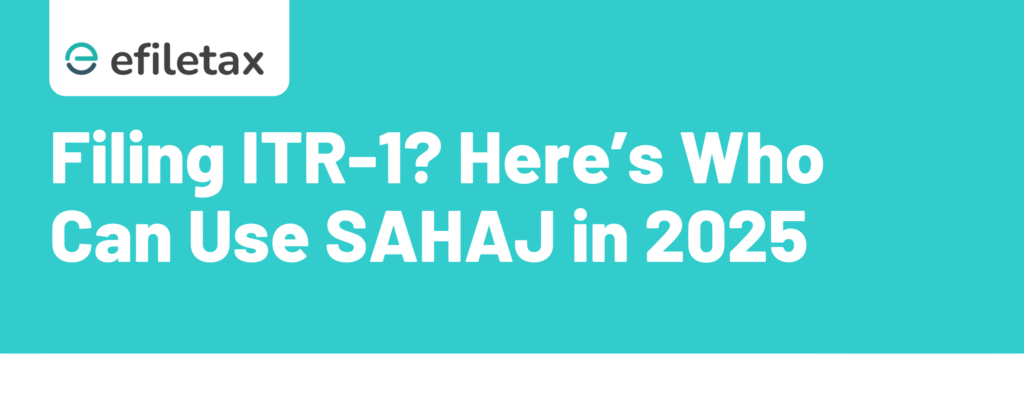
ITR-1 Filing Who Should Use SAHAJ Form?
ITR-1 filing is the most commonly used return form by individual taxpayers in India. But not everyone can file ITR-1 (SAHAJ) — the form has specific eligibility conditions and exclusions.
In this blog, we’ll explain in simple terms:
- Who can file ITR-1
- Who cannot use ITR-1
- Income and asset limits for AY 2025–26
- Key government updates & practical tips
Let’s simplify tax filing — one form at a time.
Who Can File ITR-1 (SAHAJ)?
ITR-1 is meant for Resident Individuals (other than Not Ordinarily Resident) with total income up to ₹50 lakh from the following sources:
| Income Source | Eligible Under ITR-1? |
|---|---|
| Salary/Pension | ✅ Yes |
| One House Property (Not Let Out) | ✅ Yes |
| Other Sources (Interest, etc.) | ✅ Yes |
| Agricultural Income (up to ₹5,000) | ✅ Yes |
Note: ITR-1 is only for individuals (not for HUFs, companies, or firms).
Who Cannot File ITR-1?
You cannot file ITR-1 if:
- Your total income exceeds ₹50 lakh
- You have capital gains income
- You have more than one house property
- You are a Director in a company
- You held unlisted equity shares at any time during the year
- You have foreign assets or foreign income
- You claim deductions under Section 80QQB or 80RRB
- You have brought forward losses to carry forward
Also excluded: If you are filing under the old regime with business income under Section 115BAC(1A) for AY 2025–26, ITR-1 is not permitted.
New Updates for AY 2025–26
CBDT Notification No. 40/2025 dated 29.04.2025 made key structural updates to ITR-1 for AY 2025–26:
- Additional disclosures for choosing between new and old tax regime
- Mandatory selection of regime (opt-in/opt-out) if applicable
- PAN-Aadhaar seeding validation check in pre-fill
Read more about ITR changes for AY 2025–26 here (internal link)
Expert View: Why Filing the Right Form Matters
Filing the wrong ITR form may result in:
- Return being marked defective (Sec 139(9))
- Delay in refund processing
- Possible scrutiny or notice from CPC
🔹 “Always review Form 26AS and AIS before filing. Many salaried taxpayers miss interest income disclosures, which may trigger mismatches,” says CA Mohit Kumar, Tax Advisor at Efiletax.
Quick Checklist: Can You File ITR-1?
| Condition | ITR-1 Eligibility |
|---|---|
| Income up to ₹50 lakh | ✅ Yes |
| One house property | ✅ Yes |
| No capital gains | ✅ Yes |
| No business/professional income | ✅ Yes |
| No foreign income or foreign assets | ✅ Yes |
| Director or unlisted shares | ❌ No |
If any ❌ applies, consider ITR-2 or ITR-3 instead.
FAQs on ITR-1 Filing
Q1. Can NRI file ITR-1?
No. ITR-1 is only for Resident Individuals.
Q2. What if I have exempt income (like PF or LIC maturity)?
You can file ITR-1 if exempt income is not from agricultural sources exceeding ₹5,000.
Q3. Can I file ITR-1 if I changed jobs?
Yes, as long as income is from salary and total remains within ₹50 lakh.
Final Words: “Right Form. Right Filing.”
ITR-1 filing may look simple, but choosing the correct form is critical. If your income meets all the basic eligibility checks, SAHAJ is your go-to. Else, switch to ITR-2 or ITR-3 to stay compliant.
📲 Need help filing your return?
Efiletax Experts are just a click away – Fast. Trusted. Accurate.
Summary
ITR-1 (SAHAJ) is for resident individuals earning up to ₹50 lakh from salary, one house property, and other sources. Excludes capital gains, foreign income, directors, or those with more than one property. Updated for AY 2025–26.